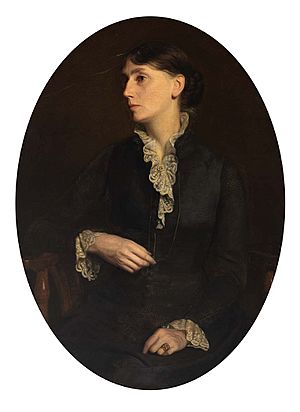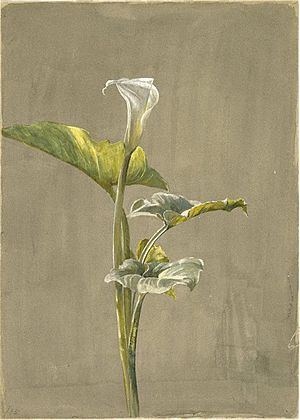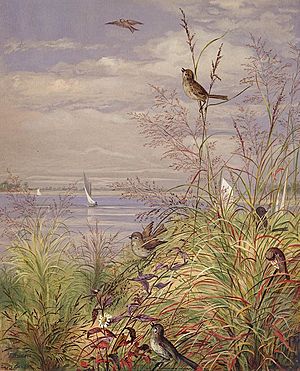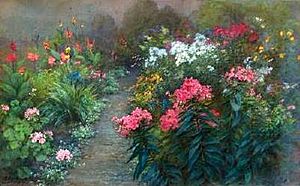Fidelia Bridges facts for kids
Quick facts for kids
Fidelia Bridges
|
|
|---|---|

Oliver Ingraham Lay (1845–1890), Fidelia Bridges, Smithsonian American Art Museum
|
|
| Born | May 19, 1834 Salem, Massachusetts, U.S.
|
| Died | May 14, 1923 (aged 88) Canaan, Connecticut, U.S.
|
| Resting place | Mountain View Cemetery, North Canaan, Connecticut |
| Nationality | American |
| Education | William Trost Richards, Pennsylvania Academy of the Fine Arts |
| Known for | Painting |
| Movement | Pre-Raphaelite |
| Patron(s) | Mark Twain |
Fidelia Bridges (born May 19, 1834 – died May 14, 1923) was an amazing American artist from the late 1800s. She was famous for her super detailed paintings of flowers, plants, and birds. She showed them exactly how they looked in nature! Even though she started with oil paints, she became a real expert in watercolor painting.
She was even the only woman among seven artists in the early days of the American Watercolor Society. You might have seen her art in books, magazines, or even on old greeting cards!
Contents
Fidelia's Early Life
Fidelia Bridges was born in Salem, Massachusetts. Her father, Henry Gardiner Bridges, was a sea captain, and her mother was Eliza Chadwick Bridges. Sadly, Fidelia became an orphan at age fifteen when both her parents passed away within months of each other.
After her parents died, Fidelia and her siblings moved to a smaller home. Her older sister, Eliza, who was a schoolteacher, became their guardian.
Fidelia started drawing when she was recovering from an illness. She became good friends with an artist named Anne Whitney. Later, Fidelia moved to Brooklyn, New York, with her family. Her sister Eliza opened a school there in 1854. When Eliza died in 1856, Fidelia and her other older sister, Elizabeth, took over running the school.
Becoming an Artist
Fidelia soon decided to focus on her art lessons instead of teaching. In 1860, inspired by her friend Anne Whitney, she joined the Pennsylvania Academy of the Fine Arts in Philadelphia. There, she studied with a famous artist named William Trost Richards. She became very close to his family.
By 1862, Fidelia had her own art studio in downtown Philadelphia. She often went on sketching trips with the Richards family to places like Lake George and the Lehigh Valley. William Trost Richards was a big supporter of the Pre-Raphaelite art style, and his ideas really influenced Fidelia's work.
Richards admired her art, saying it showed "a great joy in the beauty of nature." Through him, Fidelia met many important people in the art world who bought her paintings. She also showed her art at the Pennsylvania Academy of Fine Arts. In 1865, Fidelia moved back to Brooklyn and set up her studio in the home of the Brown family, where Anne Whitney also lived.
Studying in Rome and Career Growth
After the American Civil War, Fidelia spent a year studying art in Rome, Italy. She traveled with her friends Adeline Manning and Anne Whitney. She continued to paint detailed pictures of plants and flowers using oil paints.
When Fidelia returned to the United States in 1868, her paintings were shown at the National Academy of Design. By 1871, watercolor painting became very popular, and Fidelia quickly became known for her beautiful watercolor pictures of flowers and birds. Her art wasn't just like a photograph; she added deep meaning to her subjects, combining a romantic feeling with a scientific eye for detail.
Fidelia was known as a specialist in her field, focusing on the small, peaceful details in nature. She loved painting the wildflowers and birds she found in Stratford, Connecticut. She created some of her best paintings during her summer visits there from 1871 to 1888.
In 1873, she became an associate of the National Academy of Design. A year later, she was the only woman among seven artists in the American Society of Painters in Watercolor (now called The American Watercolor Society). She showed her work regularly from 1863 until 1908.
Art for Books and Cards
In 1876, many of Fidelia's paintings were made into prints and sold by a publisher named Louis Prang. Her illustrations appeared in magazines like St. Nicholas Magazine and Scribner's Monthly. She also illustrated a book about birds by John Burrough. This success led her to a job designing Christmas cards for Prang's company, a job she kept until 1899.
Fidelia visited England between 1879 and 1880. Her paintings from this time showed an "Oriental" style, with simple backgrounds and interesting arrangements, similar to Japanese woodblock prints by artists like Hiroshige. Her works were even shown at the Royal Academy of Arts in England.
After her trip, Fidelia returned to the Brown family's home. In 1883, she worked for a year as a governess for Mark Twain's three daughters. Mark Twain was also a collector of her artwork!
During the 1880s, Fidelia worked with illustrator Susie Barstow Skelding to create several poetry books with her bird illustrations. These included Winged Flower Lovers and Songsters of the Branches. Her bird illustrations also appeared in the books What the Poets Sing of Them and Favorite Birds.
Fidelia Bridges also showed her artwork at the Palace of Fine Arts during the 1893 World's Columbian Exposition in Chicago.
Later Life and Legacy
Fidelia Bridges never married, but she had many good friends throughout her life. In 1892, she moved to Canaan, Connecticut. She lived in a cozy cottage on a hill, with a stream nearby and a beautiful flower garden that attracted many birds. This garden became the subject of many of her paintings.
She lived a quiet life, sometimes traveling to Europe and New York. She continued to show her artwork at various exhibitions.
Fidelia was known in her village as a tall, elegant woman, even in her sixties. She was always dressed nicely, even when sketching in fields or riding her bicycle. She enjoyed woodland picnics and afternoon teas with her friends.
Fidelia Bridges was a strong supporter of nature. Along with artist Howard Pyle, she became a member of the American Forestry Association. This group was founded to protect forests in the United States.
Fidelia died on May 14, 1923, in Canaan, Connecticut, just a few days before her eighty-ninth birthday. She was buried at the Mountain View Cemetery in Canaan.
Remembering Fidelia
The Bridges family home was later named the Fidelia Bridges Guest Home in her honor. In Canaan, a bird sanctuary was also named after her.
After her death, her work was shown in special exhibitions, including Reflection of Nature at the Whitney Museum of American Art in 1984. The Smithsonian Institution has two of her works, and the Metropolitan Museum of Art in New York holds another. Her painting of the Benning Wentworth House is at the Strawbery Banke museum in Portsmouth, New Hampshire.
Gallery
-
Fidelia Bridges, Bird's Nest in Cattails, 1875, Metropolitan Museum of Art
See also
 In Spanish: Fidelia Bridges para niños
In Spanish: Fidelia Bridges para niños













